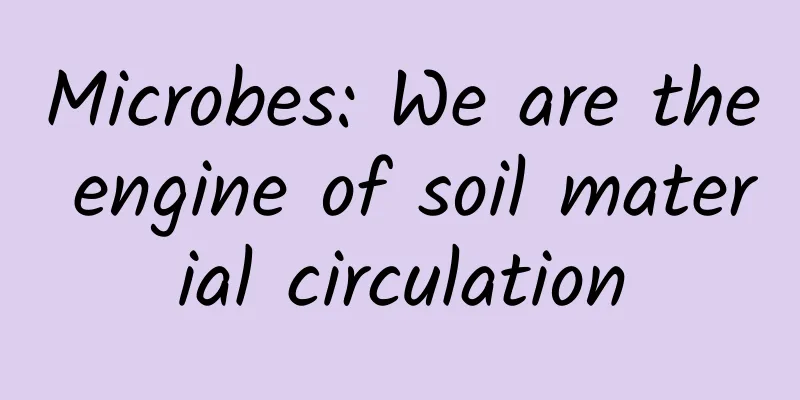Microbes: We are the engine of soil material circulation

|
Microorganisms are everywhere in nature, and soil is their base camp and the natural "culture medium" for their growth and reproduction. Soil microorganisms are a general term for all tiny organisms in the soil that are difficult to see with our naked eyes, mainly including bacteria, fungi, actinomycetes and algae. They are important components of soil, but their sizes are very small, usually measured in micrometers or millimeter. The number and variety of microorganisms in the soil are astonishing. There can be hundreds of millions to tens of billions of them in 1 gram of soil, and there are thousands or even tens of thousands of species. Bacteria are the most abundant, followed by actinomycetes and fungi, and algae are less abundant. Their number and types in the soil will change continuously according to the soil environment. Microorganisms under a microscope Image source: Veer Gallery 01 Soil microbes’ recipes Soil microorganisms are very important for soil formation and development, material circulation and plant growth. It can be said that soil is the foundation for its ability to produce products, purify water, and become the most effective carbon dioxide storage site. Like us humans, microorganisms also need to constantly obtain food from the external environment in order to survive and maintain a healthy body. The food we humans eat is called by its name, such as rice, tomatoes, beef and so on. The food of microorganisms is mainly classified according to their physiological functions in their bodies, such as carbon source, nitrogen source, growth factors, water, etc. The carbon sources commonly consumed by microorganisms mainly include sugars, organic acids, carbon dioxide, proteins, etc. The nitrogen sources that can be utilized by them mainly include proteins and their degradation products, ammonium salts, nitrates, molecular nitrogen, urea, amines, amides, etc. In addition, microorganisms also need to consume vitamins, amino acids, purines and pyrimidines to meet their own growth needs. Inorganic salts are also substances required for the growth of microorganisms, generally including phosphates, sulfates, and compounds containing elements such as sodium, potassium, calcium, magnesium, and iron. Water is also a key link in the growth of microorganisms, mainly acting as a solvent and transport medium. Not only that, water can also participate in a series of chemical reactions within its cells. 02 Soil microbial residues Important components of forest soil carbon pool Forest soil carbon pool refers to the carbon-containing organic matter present in the forest and is the most important carbon pool in terrestrial ecosystems. Trees absorb carbon dioxide from the atmosphere through photosynthesis, maintain their own growth, and produce some dead branches and leaves and dead roots. Copyright image, no permission to reprint The dead branches and leaves, dead wood, stumps and dead tree roots we see in our daily lives are all sources of forest soil carbon pools. Soil microorganisms use these organic substances as food to satisfy their own growth and reproduction. The life span of soil microorganisms is very short, generally from tens of minutes to several hours or days. They have strong reproductive capabilities and can reproduce several times or even dozens of times in a short period of time. After the death of microorganisms, some of the substances in their bodies will be absorbed and utilized by other microorganisms, while the remaining difficult-to-decompose substances will remain in the soil. We call these substances retained in the soil soil microbial residues. They can usually remain in the soil for a long time and are an important component of the forest soil organic carbon pool. Common microorganisms in forest ecosystems Source: Reference 1 03 Bacterial and fungal remains What is the difference? Soil microbial residues mainly include bacterial residues and fungal residues, both of which are important components of the forest soil carbon pool, but they are different from each other. First of all, the "food" that bacteria and fungi eat is not exactly the same, and there are also differences in their ability to absorb food. Because bacteria have weak enzyme systems, they consume more energy to "digest" these foods, and more carbon is emitted in the form of respiration, while relatively less carbon is used to synthesize biomass. On the contrary, fungi can produce more biomass due to their "strong digestive ability, good absorption, and high food utilization rate". In addition, the cytoplasm of soil microorganisms will be reused by other microorganisms after their death. The cell wall gradually forms microbial residues after turnover, but the differences in cell wall composition between bacteria and fungi will also affect the contribution of their microbial residues to the soil carbon pool. The bacterial cell wall is mainly composed of relatively easily degradable substances such as peptidoglycan, while the fungal cell wall is mainly composed of difficult-to-decompose substances such as chitin and melanin. Therefore, compared with bacterial residues, fungal residues are less edible and most microorganisms do not like to eat them. Over time, fungal residues will contribute more to the forest soil organic carbon pool than bacterial residues. 04 Microbes: It’s so cold. I don’t want to work either! Our country has a vast territory, great differences in climate between the north and the south, and rich forest types. The forests in cold regions are dominated by coniferous trees with a relatively short growing season. The dead branches and leaves contain many difficult-to-decompose substances that microorganisms do not like to eat and cannot satisfy the "appetite" of soil microorganisms. At the same time, like us humans, microorganisms are also quite "delicate", and being too hot or too cold is not conducive to their activities. The cold climate causes soil microorganisms to enter a "hibernation" state during the long winter, and organic matter that is not fully utilized by the microorganisms remains in the soil; Ultimately, the contribution of soil microbial residues to the soil organic carbon pool in forests in cold regions is lower than that in forests in warm regions. Schematic diagram of the dynamic changes of forest soil microbial residues Source: Reference 2 Forests are the largest carbon pool in terrestrial ecosystems and play a vital role in maintaining soil fertility, ensuring food security and regulating climate change. The contribution of soil microbial residues to forest organic carbon pools is almost 50%. Therefore, promoting the formation of soil microbial residues is beneficial to improving the forest carbon sequestration capacity and enhancing the carbon sink function of the forest ecosystem. Therefore, the accumulation year after year makes the contribution of soil microbial residues to the forest organic carbon pool not to be ignored. Don’t underestimate these little guys! References: [1]Peay, KG, Kennedy, PG, Talbot, JM, 2016. Dimensions of biodiversity in the Earth mycobiome. Nature Reviews Microbiology 14, 434-447. [2]Zhao, Produced by | Science Popularization China Author: Wang Qingkui and Zhao Xuechao (Institute of Applied Ecology, Chinese Academy of Sciences) Producer|China Science Expo The cover image and the images in this article are from the copyright library Reproduction of image content is not authorized |
>>: With a "click", the orthopedic surgeon broke his own bone
Recommend
We will give you 300 seed users for free, giving you your first pot of gold!
Before the formal introduction, let me say one th...
Wolves and moose entered the same isolated island: 69 years later, the wolves were extinct!
Many people may be curious about what would happe...
Chifeng SEO training: the difference between static, dynamic and pseudo-static pages
When companies are preparing to build a website, ...
Understanding Apple’s “speed reduction scandal” in one article: Is it driven by profit or a helpless move?
[[214848]] [Tencent Technology Comprehensive Repo...
A complete event operation design!
The theme of today's article is related to op...
Fourth-generation nuclear energy system, thorium-based molten salt experimental reactor, why can China lead the world?
Energy is an unavoidable topic in development, an...
Information flow placement skills to increase advertising CTR by 3 times!
Today I will share with you an optimization case ...
Which is more terrible, blindness or deafness?
What is the world like for the blind and the deaf...
If you experience these symptoms during the autumnal equinox but don’t pay attention to them, be careful that you may be suffering from Sjögren’s syndrome!
If you experience these symptoms during the autum...
When it comes to regeneration, humans are really too weak...
In superhero movies, regeneration is a powerful s...
Why do ants have such clear division of labor? It turns out that their brain circuits are different
In the evolution of animals, a major turning poin...
Is Lenovo’s change what Yang Yuanqing wanted?
In just one week, Fan Bingbing's "Jun Ge...
2015 App Operation and Promotion Strategy (Full Version)
The basic tone of the APP operation and promotion...
Didi "Hua Xiaozhu" taxi product analysis report
Hua Xiaozhu is an app owned by Didi , known as th...
How can online and offline APPs complement each other’s strengths?
The specific strategies for enterprises to implem...









